Self-guided apartment tours offer a convenient, flexible way for renters to explore properties independently. Using online tools, they can screen and visit apartments at their own pace.
What Are Self-Guided Apartment Tours?
Self-guided apartment tours allow renters to explore properties independently without a real estate agent.Prospective tenants access units using unique codes or keys, enabling them to tour at their own pace. This method offers flexibility and convenience, reducing the need for scheduled appointments. It’s particularly popular in today’s fast-paced rental market, where efficiency and autonomy are highly valued by renters.
These tours often leverage technology, such as digital lockboxes or mobile apps, to grant secure access. Renters can assess amenities, layout, and condition firsthand, making informed decisions without pressure. Self-guided tours are ideal for those seeking a hassle-free and personalized rental experience.
Why Choose Self-Guided Tours?
The rise of self-guided apartment tours reflects a shift toward convenience and efficiency in the rental market. These tours allow renters to explore properties at their own pace, eliminating the need for rigid schedules. They provide unparalleled flexibility, enabling prospective tenants to assess apartments without the pressure of an agent’s presence. This method is particularly appealing to those valuing autonomy and time efficiency in their rental search.
By reducing the necessity for multiple scheduled appointments, self-guided tours streamline the rental process. They empower renters to make informed decisions by offering a stress-free environment to evaluate spaces thoroughly. This approach is ideal for busy individuals seeking a seamless and personalized experience when searching for their next home.
Benefits of Self-Guided Apartment Tours
Self-guided apartment tours offer numerous advantages, including increased flexibility and convenience. Renters can explore properties at their own pace, allowing for a more thorough evaluation. These tours eliminate the pressure of a guided schedule, enabling prospective tenants to focus on key features. Additionally, they provide an opportunity to revisit spaces virtually, enhancing decision-making. This approach streamlines the rental process, saving time and reducing stress for those seeking a new home.
Another significant benefit is the ability to personalize the experience. Renters can prioritize properties based on their preferences, ensuring they make the most of their time. Self-guided tours also empower individuals to assess apartments independently, fostering a more authentic connection to the space. This method is particularly advantageous for those who value autonomy and efficiency in their rental search.

Preparing for a Self-Guided Apartment Tour
Research neighborhoods, create a checklist of priorities, and use online tools to narrow down options. This ensures an efficient and focused apartment hunting experience.
Researching Potential Apartments
Researching potential apartments involves using online databases and tools to filter properties by location, price, and amenities. Utilize Boolean operators like AND, OR, and NOT to refine searches. Evaluate neighborhoods, proximity to essential services, and reviews from current or former tenants. This step ensures you focus on properties that align with your needs and preferences, saving time during in-person visits.
Creating a Checklist of Requirements
Developing a checklist of requirements helps prioritize needs during self-guided tours. Include essentials like bedroom count, square footage, and amenities. Note preferences for location, proximity to transit, and budget. This structured approach ensures you evaluate properties consistently, making comparisons easier and decision-making more efficient. Tailor the list to reflect personal priorities and lifestyle needs.
Using Online Tools for Initial Screening
Online tools simplify the initial screening process by allowing renters to filter properties based on criteria like price, location, and amenities. Virtual tours and high-quality images provide a detailed preview of spaces. Interactive maps and neighborhood insights help assess proximity to essential services. Reviews and ratings from current or former tenants offer valuable perspectives, enabling renters to narrow down options efficiently before scheduling visits.

Technology and Tools for Self-Guided Tours
Virtual tour platforms, scheduling apps, and online databases streamline self-guided apartment tours. These tools enable renters to explore properties remotely, filter options, and plan visits efficiently.
Virtual Tour Platforms
Virtual tour platforms provide immersive 360-degree views of apartments, enabling renters to explore properties remotely. These tools often include interactive features like zoom, floor plans, and room labels. They allow renters to assess layouts, amenities, and condition without physical visits, making the initial screening process efficient and convenient. This technology is particularly useful for long-distance renters or those with busy schedules.
Apartment Listing Websites
Apartment listing websites are essential tools for self-guided tours, offering detailed property descriptions, photos, and virtual tours. Platforms like Zillow, Realtor.com, and Apartments.com allow renters to filter by location, price, and amenities. They provide a centralized hub to compare properties and neighborhoods, streamlining the search process. Many sites also enable renters to schedule visits directly, making it easier to plan in-person tours at their convenience.
Apps for Scheduling Visits
Apps like Calendly and RentCafe streamline the process of scheduling self-guided apartment tours. These platforms allow renters to select available time slots and receive confirmation instantly. Many apps also provide real-time notifications and detailed visit instructions. This technology enhances efficiency, reducing the need for back-and-forth communication and ensuring a seamless experience for both renters and property managers.
Legal and Safety Considerations
Understanding lease terms, rental laws, and personal safety is crucial for self-guided tours. Ensure compliance with property rules and document any issues for liability protection.
Understanding Rental Agreements
Understanding rental agreements is essential for self-guided apartment tours. These documents outline tenant responsibilities, lease terms, and property rules. Reviewing the agreement ensures clarity on rent, deposits, and policies. It also protects both tenants and landlords by establishing clear expectations. Always read and understand the terms before signing to avoid disputes. This step is crucial for a smooth rental experience.
Safety Tips for Solo Tours
When conducting self-guided apartment tours alone, prioritize safety. Inform someone about your schedule and locations. Arrive during daylight if possible. Carry a fully charged phone and keep emergency contacts handy. Be observant of your surroundings and trust your instincts. Avoid visiting unfamiliar areas at night. Ensure all doors and windows are secure before leaving. Stay vigilant to ensure a safe experience.
Liability and Insurance
Understanding liability and insurance is crucial for self-guided apartment tours. Renters should verify if they’re covered by the property’s insurance or their own during visits. Damage to the property or personal injury may fall under specific policies. Request proof of insurance from landlords and review rental agreements for liability clauses. Clarifying these details ensures both parties are protected and minimizes potential risks during the tour process.
Etiquette for Self-Guided Apartment Tours
Respect the property by leaving it tidy and not touching personal items. Be punctual, communicate clearly with landlords, and inform them of any damages or concerns found during the tour.
Respecting the Property
When conducting a self-guided apartment tour, it’s essential to treat the property with care. Avoid causing damage, keep the space tidy, and refrain from touching personal items. Leave the apartment in the same condition as you found it, removing any trash and ensuring all doors and windows are secure upon departure. This demonstrates respect for the landlord’s property and maintains a professional relationship.
Communicating with Landlords
Effective communication with landlords is crucial during self-guided tours. Be polite, responsive, and professional in inquiries. Ask questions about amenities, lease terms, or repairs. Provide timely feedback and notify them of any issues found during the tour. Respect their time and property, ensuring smooth interaction. Clear communication helps build trust and facilitates a positive rental experience for both parties.
Being Mindful of Neighbors
During self-guided tours, respect neighbors by minimizing noise and disruptions. Avoid entering shared spaces unless permitted. Introduce yourself if encountered, and be courteous. Maintaining a positive interaction fosters a welcoming environment. Observing community rules ensures a harmonious experience for everyone involved, reflecting your consideration as a potential resident.
Comparing Self-Guided vs. Guided Tours
Self-guided tours offer flexibility and independence, allowing renters to explore properties at their own pace. Guided tours provide personalized insights and expert guidance, enhancing the decision-making process.
Advantages of Self-Guided Tours
Self-guided apartment tours offer flexibility, independence, and cost-effectiveness. Renters can explore properties at their own pace, spending as much time as needed. This approach reduces the pressure of rushed decisions and allows for a more personalized experience. Additionally, online tools enable initial screening, helping renters shortlist properties efficiently before in-person visits.
Disadvantages of Self-Guided Tours
Self-guided apartment tours may lack personalized guidance, leaving renters unsure of key details. Safety concerns arise for solo visitors, especially in unfamiliar areas. Additionally, without immediate answers to questions, renters may miss critical information. Liability issues can also emerge if accidents occur during visits, as responsibility may be unclear. Relying solely on online tools can sometimes misrepresent properties, leading to disappointment upon arrival.
When to Choose Guided Tours
Guided tours are ideal for renters seeking personalized attention, expert insights, and real-time answers. They are particularly beneficial for first-time renters or those unfamiliar with the area. Guided tours also enhance safety, as a representative accompanies the visit. Additionally, they save time by focusing on pre-screened properties, making them efficient for those with limited availability or needing a hands-on experience to make informed decisions.

Budgeting for Self-Guided Apartment Tours
Budgeting for self-guided tours involves calculating visit costs, allocating funds for transportation, and managing time efficiently to avoid unnecessary expenses while exploring properties independently.
Calculating Costs of Visits
Calculating visit costs involves assessing transportation, time, and potential application fees. Budgeting strategies help renters allocate funds wisely, ensuring they explore properties without overspending. Planning ahead is key.
Allocating Funds for Transportation
Allocating Funds for Transportation
Allocating funds for transportation is crucial for self-guided tours. Budgeting for public transit, ride-sharing, or parking ensures renters can visit properties without financial strain. Researching travel costs and using apps to estimate expenses helps in planning effectively. Creating a transportation budget breakdown prevents overspending and ensures a smooth apartment-hunting experience.
Managing Time Effectively
Managing time effectively is essential for self-guided apartment tours. Create a detailed itinerary to prioritize visits, ensuring you allocate specific time slots for each property. Use apps or calendars to stay organized and avoid overlapping schedules. Plan breaks to maintain energy levels and focus. Avoid overloading your schedule to allow for unexpected delays, ensuring a stress-free and productive experience.

Time Management for Self-Guided Tours
Plan your schedule meticulously, allocating specific time slots for each property visit. Utilize digital tools to stay organized and ensure efficiency throughout the process.
Creating an Itinerary
Develop a detailed schedule, prioritizing properties based on preferences. Allocate specific time slots for each visit, ensuring efficient travel between locations. Use digital tools or apps to organize and track your itinerary, minimizing delays. A well-planned schedule allows for a systematic approach, helping you make the most of your self-guided apartment tour experience.
Prioritizing Properties
Prioritizing properties is essential for an efficient self-guided tour. Start by evaluating amenities, location, and budget. Use online tools to filter and rank apartments based on your preferences. Focus on high-priority options first to maximize your time. This approach ensures you visit the most promising properties, helping you make informed decisions and streamline your search process effectively.
Allowing Time for Unexpected Delays
Unexpected delays are common during self-guided tours. Traffic, longer-than-expected walk-throughs, or technical issues with access codes can arise. To manage this, pad your schedule with extra time between visits. This flexibility ensures you can handle setbacks without rushing, allowing for a more relaxed and thorough evaluation of each property. It reduces stress and helps you make better decisions.
Documenting Your Self-Guided Tour
Documenting your self-guided tour helps compare properties later. Take photos, videos, and notes on pros, cons, and measurements. This ensures you remember key details accurately.
Taking Photos and Videos
Taking photos and videos during self-guided tours captures essential details of the apartment. Focus on key areas like the kitchen, bathroom, and natural lighting. Document any damage or unique features. Videos provide a panoramic view, helping you visualize the space later; Organize your media for easy comparison and future reference, ensuring you don’t overlook important aspects when making your decision.
Noting Pros and Cons
Documenting pros and cons during self-guided tours helps evaluate properties objectively. Use a checklist or digital tool to note features like space, lighting, and condition. Highlight advantages such as modern appliances or proximity to amenities, and list drawbacks like noise or outdated finishes. Organizing these observations aids in comparing properties and making informed decisions, ensuring no important details are overlooked during the process.
Recording Measurements
Recording measurements during self-guided apartment tours is essential for planning and comparison. Use a tape measure or smartphone app to document room dimensions, doorways, and storage spaces. Note the size of key areas like the bedroom, kitchen, and bathroom. This data helps visualize furniture placement and ensures a smooth transition when moving. Accurate measurements are crucial for making informed decisions about the suitability of the space for your needs.
Space Planning and Visualization
Self-guided tours enable renters to visualize living spaces, measure rooms, and plan furniture layouts. This process helps in making informed decisions about the apartment’s functionality and fit.
Measuring Rooms
Measuring rooms during self-guided tours ensures accurate space assessment. Use a laser meter or measuring tape to record dimensions, aiding in furniture planning and layout visualization. This step helps verify if belongings fit, check doorway widths, and assess storage capacity. Precise measurements prevent surprises post-move-in, ensuring a smooth transition and informed decision-making about the apartment’s suitability for your needs.
Visualizing Furniture Layout
Visualizing furniture layout during self-guided tours helps renters imagine how their belongings will fit. Use online tools like 3D floor plans or augmented reality apps to map out spaces. This process ensures furniture fits comfortably, doorways are wide enough, and the flow of the apartment meets your lifestyle needs. Taking photos and notes aids in planning and decision-making post-tour.
Assessing Storage Space
When assessing storage space during self-guided tours, inspect closets, cabinets, and pantries for size and functionality. Consider additional storage options like basements or attics if available. Check for adjustable shelves or built-in organizers, and ensure spaces are clean and free from damage. Adequate storage is essential for a clutter-free living environment, making it a key factor in your decision-making process.
Evaluating the Condition of the Apartment
Evaluate the apartment’s condition by inspecting walls, floors, and windows for damage. Check for signs of wear, leaks, or needed repairs to ensure the space is livable.
Checking for Damage
During a self-guided tour, inspect walls, floors, and windows for cracks, dents, or water damage. Check for signs of wear, such as peeling paint or warped surfaces. Look for leaks under sinks and around appliances. Test doors and windows to ensure they open and close properly. Note any structural issues or needed repairs to assess the apartment’s overall condition and potential maintenance needs.
Inspecting Appliances
Inspecting appliances during a self-guided tour is essential to ensure they are functional and in good condition. Check refrigerators, ovens, dishwashers, and microwaves for proper operation. Look for signs of wear, rust, or damage. Test each appliance to confirm it works. Note any issues, such as leaks or unusual noises, and document them for further discussion with the landlord or property manager.
Identifying Hidden Issues
During a self-guided tour, identifying hidden issues is crucial to avoid future problems. Check for water damage, pest signs, or mold in corners and behind appliances. Look for cracks in walls or ceilings and test plumbing and electrical systems. Pay attention to unusual odors or noises. A thorough inspection helps uncover potential issues that may not be immediately visible, ensuring a well-informed decision.

Final Tips for a Successful Self-Guided Tour
Be thorough, prepared, and organized to ensure a successful self-guided tour. Document findings, evaluate pros and cons, and make informed decisions confidently.
Asking Questions
Asking questions during a self-guided tour is crucial for gathering essential information. Inquire about lease terms, utility costs, and maintenance policies. Clarify parking rules, pet policies, and neighborhood safety. Identify potential issues like water damage or pests. Use this opportunity to understand the landlord’s expectations and verify the apartment’s condition. Asking questions ensures clarity and helps make an informed decision tailored to your needs.
Seeking a Second Opinion
Seeking a second opinion during a self-guided apartment tour can provide valuable insights. Involve a trusted friend, family member, or roommate to evaluate the space objectively. They may notice details you overlooked, such as potential issues or layout flaws. Discussing with others ensures a balanced perspective and helps prioritize needs over wants. A second opinion can also clarify concerns about lease terms or property condition, aiding in a more informed decision.
Making an Informed Decision
Making an informed decision during a self-guided apartment tour involves evaluating the property’s suitability for your needs. Assess the apartment’s condition, layout, and amenities against your checklist. Consider long-term practicality, such as commute proximity and neighborhood safety. Weigh the pros and cons, review lease terms, and ensure the rental fits your budget. A thorough evaluation ensures a confident and well-reasoned choice.
